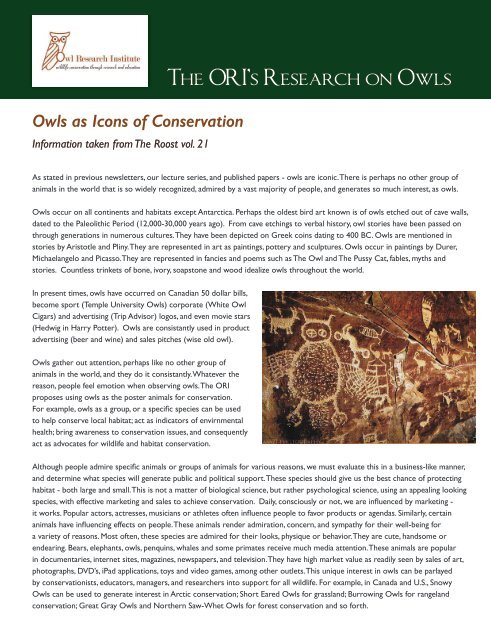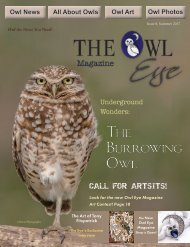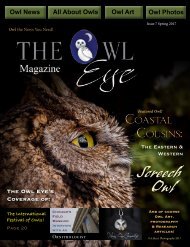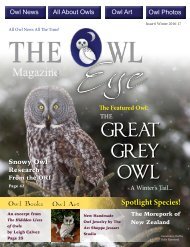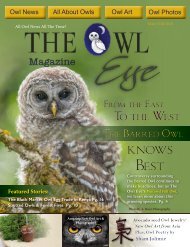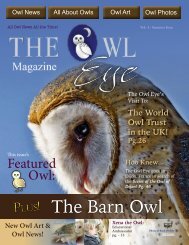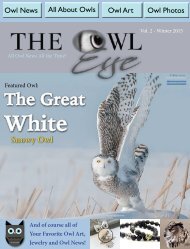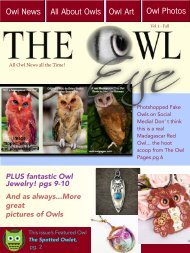The Owl Eye Magazine Issue 9
Create successful ePaper yourself
Turn your PDF publications into a flip-book with our unique Google optimized e-Paper software.
<strong>Owl</strong>s as Icons of Conservation<br />
Information taken from <strong>The</strong> Roost vol. 21<br />
<strong>The</strong> ORI’s Research on <strong>Owl</strong>s<br />
As stated in previous newsletters, our lecture series, and published papers - owls are iconic. <strong>The</strong>re is perhaps no other group of<br />
animals in the world that is so widely recognized, admired by a vast majority of people, and generates so much interest, as owls.<br />
<strong>Owl</strong>s occur on all continents and habitats except Antarctica. Perhaps the oldest bird art known is of owls etched out of cave walls,<br />
dated to the Paleolithic Period (12,000-30,000 years ago). From cave etchings to verbal history, owl stories have been passed on<br />
through generations in numerous cultures. <strong>The</strong>y have been depicted on Greek coins dating to 400 BC. <strong>Owl</strong>s are mentioned in<br />
stories by Aristotle and Pliny. <strong>The</strong>y are represented in art as paintings, pottery and sculptures. <strong>Owl</strong>s occur in paintings by Durer,<br />
Michaelangelo and Picasso. <strong>The</strong>y are represented in fancies and poems such as <strong>The</strong> <strong>Owl</strong> and <strong>The</strong> Pussy Cat, fables, myths and<br />
stories. Countless trinkets of bone, ivory, soapstone and wood idealize owls throughout the world.<br />
In present times, owls have occurred on Canadian 50 dollar bills,<br />
become sport (Temple University <strong>Owl</strong>s) corporate (White <strong>Owl</strong><br />
Cigars) and advertising (Trip Advisor) logos, and even movie stars<br />
(Hedwig in Harry Potter). <strong>Owl</strong>s are consistantly used in product<br />
advertising (beer and wine) and sales pitches (wise old owl).<br />
<strong>Owl</strong>s gather out attention, perhaps like no other group of<br />
animals in the world, and they do it consistantly. Whatever the<br />
reason, people feel emotion when observing owls. <strong>The</strong> ORI<br />
proposes using owls as the poster animals for conservation.<br />
For example, owls as a group, or a specific species can be used<br />
to help conserve local habitat; act as indicators of envirnmental<br />
health; bring awareness to conservation issues, and consequently<br />
act as advocates for wildlife and habitat conservation.<br />
Although people admire specific animals or groups of animals for various reasons, we must evaluate this in a business-like manner,<br />
and determine what species will generate public and political support. <strong>The</strong>se species should give us the best chance of protecting<br />
habitat - both large and small. This is not a matter of biological science, but rather psychological science, using an appealing looking<br />
species, with effective marketing and sales to achieve conservation. Daily, consciously or not, we are influenced by marketing -<br />
it works. Popular actors, actresses, musicians or athletes often influence people to favor products or agendas. Similarly, certain<br />
animals have influencing effects on people. <strong>The</strong>se animals render admiration, concern, and sympathy for their well-being for<br />
a variety of reasons. Most often, these species are admired for their looks, physique or behavior. <strong>The</strong>y are cute, handsome or<br />
endearing. Bears, elephants, owls, penquins, whales and some primates receive much media attention. <strong>The</strong>se animals are popular<br />
in documentaries, internet sites, magazines, newspapers, and television. <strong>The</strong>y have high market value as readily seen by sales of art,<br />
photographs, DVD’s, iPad applications, toys and video games, among other outlets. This unique interest in owls can be parlayed<br />
by conservationists, educators, managers, and researchers into support for all wildlife. For example, in Canada and U.S., Snowy<br />
<strong>Owl</strong>s can be used to generate interest in Arctic conservation; Short Eared <strong>Owl</strong>s for grassland; Burrowing <strong>Owl</strong>s for rangeland<br />
conservation; Great Gray <strong>Owl</strong>s and Northern Saw-Whet <strong>Owl</strong>s for forest conservation and so forth.


